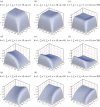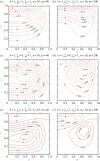Electro-osmotic flow in a rotating rectangular microchannel
- PMID: 26345088
- PMCID: PMC4528667
- DOI: 10.1098/rspa.2015.0200
Electro-osmotic flow in a rotating rectangular microchannel
Abstract
An analytical model is presented for low-Rossby-number electro-osmotic flow in a rectangular channel rotating about an axis perpendicular to its own. The flow is driven under the combined action of Coriolis, pressure, viscous and electric forces. Analytical solutions in the form of eigenfunction expansions are developed for the problem, which is controlled by the rotation parameter (or the inverse Ekman number), the Debye parameter, the aspect ratio of the channel and the distribution of zeta potentials on the channel walls. Under the conditions of fast rotation and a thin electric double layer (EDL), an Ekman-EDL develops on the horizontal walls. This is essentially an Ekman layer subjected to electrokinetic effects. The flow structure of this boundary layer as a function of the Ekman layer thickness normalized by the Debye length is investigated in detail in this study. It is also shown that the channel rotation may have qualitatively different effects on the flow rate, depending on the channel width and the zeta potential distributions. Axial and secondary flows are examined in detail to reveal how the development of a geostrophic core may lead to a rise or fall of the mean flow.
Keywords: Ekman layer; electric double layer; electro-osmotic flow; rotating channel; secondary flow.
Figures








Similar articles
-
Rotating electro-osmotic flow over a plate or between two plates.Phys Rev E Stat Nonlin Soft Matter Phys. 2011 Nov;84(5 Pt 2):056320. doi: 10.1103/PhysRevE.84.056320. Epub 2011 Nov 22. Phys Rev E Stat Nonlin Soft Matter Phys. 2011. PMID: 22181511
-
Effective slip for flow in a rotating channel bounded by stick-slip walls.Phys Rev E. 2016 Dec;94(6-1):063115. doi: 10.1103/PhysRevE.94.063115. Epub 2016 Dec 28. Phys Rev E. 2016. PMID: 28085377
-
Electro-osmotic peristaltic flow and heat transfer in an ionic viscoelastic fluid through a curved micro-channel with viscous dissipation.Proc Inst Mech Eng H. 2022 Aug;236(8):1080-1092. doi: 10.1177/09544119221105848. Epub 2022 Jun 23. Proc Inst Mech Eng H. 2022. PMID: 35735142
-
Electro-osmotic flow through a two-dimensional screen-pump filter.Phys Rev E Stat Nonlin Soft Matter Phys. 2011 Sep;84(3 Pt 2):036301. doi: 10.1103/PhysRevE.84.036301. Epub 2011 Sep 1. Phys Rev E Stat Nonlin Soft Matter Phys. 2011. PMID: 22060486
-
Effect of electrical double layer on electric conductivity and pressure drop in a pressure-driven microchannel flow.Biomicrofluidics. 2010 Feb 25;4(1):14104. doi: 10.1063/1.3328091. Biomicrofluidics. 2010. PMID: 20644673 Free PMC article.
References
-
- Duffy DC, Gillis HL, Lin J, Sheppard NF, Jr, Kellogg GJ. 1999. Microfabricated centrifugal microfluidic systems: characterization and multiple enzymatic assays. Anal. Chem. 71, 4669–4678. (doi:10.1021/ac990682c) - DOI
-
- Chang CC, Wang CY. 2011. Rotating electro-osmotic flow over a plate or between two plates. Phys. Rev. E 84, 056320 (doi:10.1103/PhysRevE.84.056320) - DOI - PubMed
-
- Xie ZY, Jian YJ. 2014. Rotating electroosmotic flow of power-law fluids at high zetapotentials. Colloids Surf. A, Physicochem. Eng. Aspects 461, 231–239. (doi:10.1016/j.colsurfa.2014.07.051) - DOI
-
- Li SX, Jian YJ, Xie ZY, Liu QS, Li FQ. 2015. Rotating electro-osmotic flow of third grade fluids between two microparallel plates. Colloids Surf. A, Physicochem. Eng. Aspects 470, 240–247. (doi:10.1016/j.colsurfa.2015.01.081) - DOI
-
- Gorkin R et al. 2010. Centrifugal microfluidics for biomedical applications. Lab Chip 10, 1758–1773. (doi:10.1039/b924109d) - DOI - PubMed
LinkOut - more resources
Full Text Sources
Other Literature Sources

